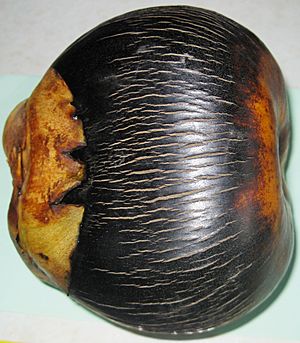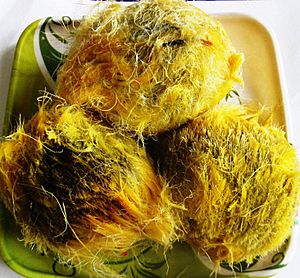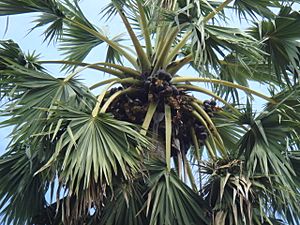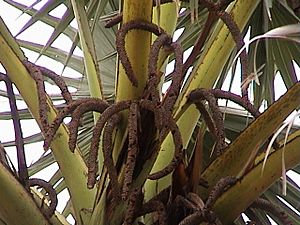Doub palm facts for kids
Quick facts for kids Doub palm |
|
|---|---|
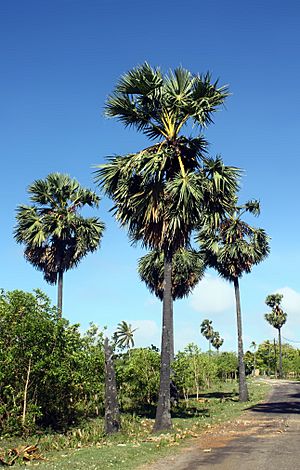 |
|
| Scientific classification | |
| Genus: |
Borassus
|
| Species: |
flabellifer
|
| Synonyms | |
The Borassus flabellifer, also known as the palmyra palm, toddy palm, or ice apple, is a very useful tree. It grows naturally in parts of South Asia, like Bangladesh and South India, and also in Southeast Asia. You can also find it growing in places like Socotra and parts of China.
Contents
Description
The palmyra palm is a strong tree that can grow up to 30 meters (about 100 feet) tall. Its trunk is grey and has rings from where old leaves used to be. The old leaves stay on the tree for a few years before they fall off.
The leaves are shaped like a fan and can be 3 meters (about 10 feet) long. They have strong black teeth along their edges. Like other Borassus trees, the palmyra palm has separate male and female plants. This means male flowers grow on one tree, and female flowers grow on another.
The male flowers are small, less than 1 centimeter long. They grow in small groups hidden under scales on a special flower stalk called an inflorescence. The female flowers are much bigger, about the size of a golf ball, and grow alone on their own flower stalk.
After pollination (when pollen from a male flower reaches a female flower), the female flowers grow into large, fleshy fruits. These fruits are 15–25 centimeters (6–10 inches) wide and usually have 1 to 3 seeds inside. The fruits are black or brown and have a sweet, stringy pulp. Each seed is protected by a hard, woody shell. Young palmyra seedlings grow slowly at first, but then they grow quickly and develop a strong trunk.
Uses
The palmyra palm is very useful, with many parts of the tree being used by people.
Fruit
The fruit, called palmyra fruit or ice apple, is about 10 to 18 centimeters (4 to 7 inches) wide. It has a black outer skin and grows in bunches. To eat it, you cut off the top part to find sweet, clear, pale-white jelly-like seed parts inside. These look a bit like lychee fruit but have a milder taste and no pit. Each fruit can have two, three, or four of these jelly parts. The jelly is covered with a thin, yellowish-brown skin and has watery fluid inside.
In some areas, like Bengal, this jelly has inspired special sweets called jalbhora. The soft, orange-yellow pulp of the ripe fruit is sweet and good to eat. It is rich in vitamins A and C.
People often eat the seeds when the outer fruit is still unripe. But if the whole fruit ripens, its stringy outer layer can also be eaten raw, boiled, or roasted. When fully ripe, the fruit turns purple-black and tastes similar to coconut flesh. The skin can also be eaten, much like how mango skins are sometimes eaten. In Bengal, people make many sweet dishes from the yellowish liquid of the ripe palm fruit. These include fried taal-er bora (palmyra fritters) or taal-kheer (a sweet pudding).
The fruit has different names in various regions:
- Nonku in Kerala, India.
- Nungu in Tamil Nadu, India.
- Tala in Odisha, India.
- Buah lontar or siwalan in Indonesia.
- Taati Nungu in Karnataka, India.
- Thaati Munjalu in Telangana and Andhra Pradesh, India.
-
Preparing palmyra seeds at a road stall in Myanmar.
-
A pot used to collect toddy or palm wine in India.
-
Edible jelly seeds of palmyra palm, called Thaati Munjalu, in Guntur, India.
Sap
A sweet liquid called toddy can be collected from the young flower stalks of the palm. This is done by tapping the top shoots and collecting the dripping juice in hanging pots. If the juice is collected in the evening or left to ferment, it becomes sour. This sour sap is called Tadi in Marathi.
Before sugarcane became common, this sap was the main source of sugar in Thailand. The Thai word for sugar, nam tan, actually means "water of the tala palm."
Toddy can be fermented to make a drink called arrack. It can also be boiled down to make a raw sugar called jaggery. This sugar is known as Taal Patali in Bengali and Pana Vellam or Karuppukatti in Tamil. In Indonesia, it's called Gula Jawa (Javanese sugar) and is used a lot in their cooking.
Sprouts
In parts of India and Sri Lanka, the seeds of the palmyra palm are planted and allowed to sprout. The fleshy stems that grow underground are then boiled or roasted and eaten. They are very fibrous and healthy.
These sprouts have different names:
- Thegalu or Gaygulu or Gengulu in Telugu.
- Panai Kizhangu or Panangkizhangu in Tamil.
- Htabin myiq in Myanmar.
The hard shell of the sprouted seed can also be opened to get a crunchy kernel inside. This kernel tastes like a sweeter water chestnut. It's called Buragunju in Telugu and "thavanai" in Tamil.
Leaves
The leaves of the palmyra palm are used for many things. They are used to make roofs, mats, baskets, fans, hats, and umbrellas. They were also used as a material for writing.
In ancient times, many old writings in Tamil and Telugu were written on dried palm leaves. These are known as palm-leaf manuscripts.
In Indonesia, these leaves were used as paper in old cultures. They were called "lontar." Special leaves were chosen, boiled in salt water with turmeric (to preserve them), and then dried. Once dry, they were polished, cut to size, and a hole was made in one corner. Each leaf could make four pages. People wrote on them using a sharp tool called a stylus.
The stem of the leaves has sharp, thorny edges. The outer skin of the stem can be peeled off and used to make ropes or to weave into beds. In some parts of Tamil Nadu, a type of rice flour cake called "Kozhukattai" is made using the leaves. In eastern India, the leaves are used to make hand fans.
Trunk
The strong stalks of the palm are used to make fences. They also provide a tough, wiry fiber that can be used for ropes and brushes. The black wood from the trunk is very hard, heavy, and lasts a long time. It is highly valued for building and construction. It is even stronger than coconut timber.
Crown
When the top part of the tree (the crown) is removed, the section where the leaves grow out is an edible cake. This is called pananchoru in Tamil or thati adda in Telugu.
Roots
In Cambodia, where the palm is called thnôt, the roots are dried and smoked. People use them to help with nasal problems.
Cultivation
The palmyra palm is a beautiful tree with a large size and clean appearance. Because of this, it is often planted in gardens and parks as an ornamental tree.
Cultural symbolism
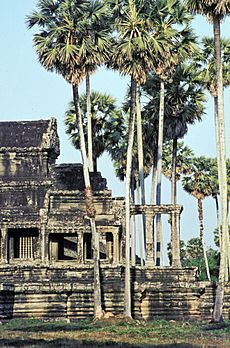
- The palmyra tree is the official tree of Tamil Nadu, a state in India. It is highly respected in Tamil culture and is called "katpaha tharu," which means "celestial tree," because every part of it has a use. There is an ancient tree deity (a god related to trees) called Panaiveriyamman, named after panai, the Tamil name for the palmyra palm. This deity is linked to fertility.
- The Asian palmyra palm is a symbol of Cambodia. It is a very common palm found all over the country and grows near the famous Angkor Wat temple.
- In Indonesia, the palmyra tree is the symbol of the South Sulawesi province.
- This plant has also inspired many people, especially in Bengal. The famous poet Rabindranath Tagore wrote a popular nursery rhyme about the palmyra tree, which is read in many schools in West Bengal and Bangladesh.
- In the Hindu epic Mahabharata, a palmyra tree is shown on the chariot-banner of the warrior Bheeshma.
See also
 In Spanish: Palma de Palmira para niños
In Spanish: Palma de Palmira para niños


